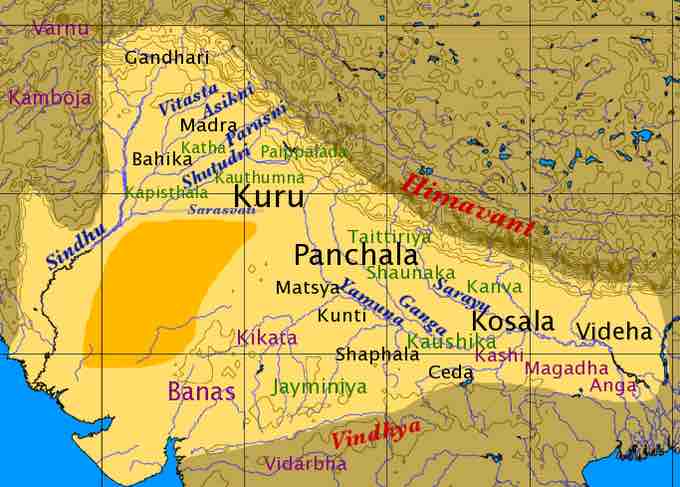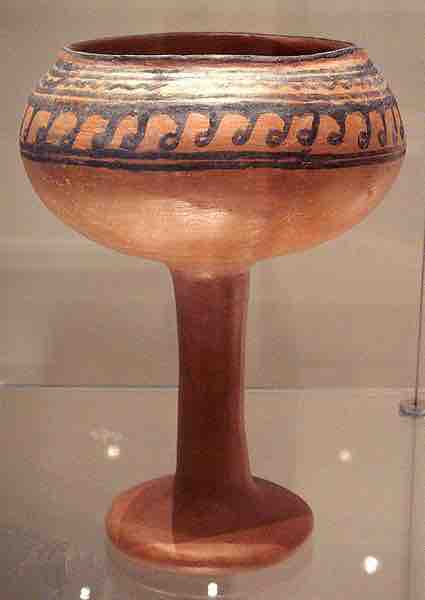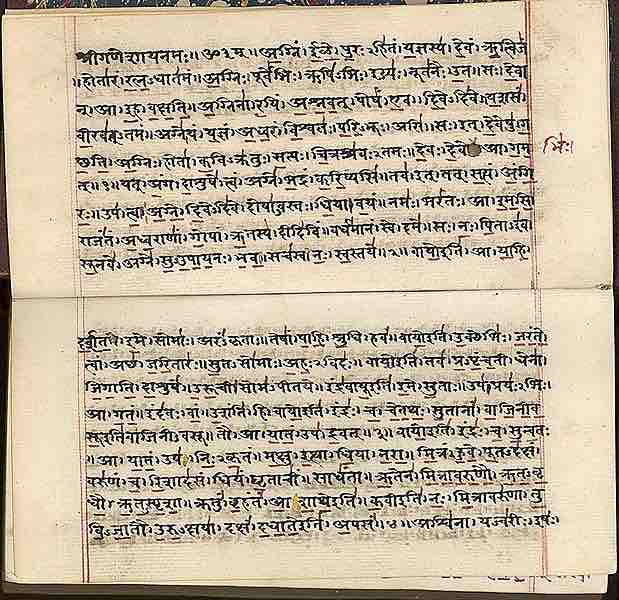Overview: India's Vedic Period
The Vedic period (or Vedic age) in India was a period in history during which the Vedas, the oldest scriptures of Hinduism, were composed. The time span of the period is uncertain, though is thought to span from 1700 BCE to about 500 BCE, with 150 BCE suggested as a terminus ante quem (the latest possible time) for all Vedic Sanskrit literature. Transmission of texts in the Vedic period was by oral tradition alone, and a literary tradition began only in post-Vedic times.
The associated culture, sometimes referred to as the Vedic civilization, was probably centered in the northern and northwestern parts of the Indian subcontinent, but it has now spread and constitutes the basis of contemporary Indian culture. In the 11th century BCE, the Vedic society transitioned from semi-nomadic life to settled agriculture. This transition led to an increase in trade and increased competition and conflicts over resources, such as land and water. However, after 1000 BCE, the use of iron axes and ploughs enabled the clearing of jungles, and the Vedic kingdoms were able to expand along the Gangetic plains, ushering in the later Vedic age.

Map of northen India in the later Vedic Period
The Vedic civilization is thought to have been centered in the northern and northwestern parts of the Indian subcontinent. Here, river Indus is shown by its Sanskrit name Sindhu. The location of Vedic shakhas is labelled in green, and the Thar desert is in orange.
By the 6th century BCE, various political units consolidated into large kingdoms called Mahajanapadas. The process of urbanization had begun in these kingdoms, and commerce and travel—even over regions separated by large distances—became easy. The end of Vedic India is marked by linguistic, cultural, and political changes. The grammar of Pāini marks a final apex in the codification of Sutra texts and, at the same time, the beginning of Classical Sanskrit. The invasion of Darius I of the Indus valley in the early 6th century BCE marks the beginning of outside influence, continued in the kingdoms of the Indo-Greeks. After the end of the Vedic period, the Mahajanapadas period in turn gave way to the Maurya Empire (from c. 320 BCE), considered to be the golden age of classical Sanskrit literature.
Crafts in the Vedic Period
Crafts within Vedic culture included that of chariot-making, cart-making, carpentry, metal-working (creating instruments such as razors, bangles, and axes), tanning, bow-making, sewing, weaving, and making of mats of grass and reed. Many of these might have required full-time specialists. The usage of iron implements (krishna-ayas or shyama-ayas, literally meaning black metal or dark metal) increased in the later Vedic age, and new crafts and occupations such as leather work, pottery, astrology, jewelry, dying, and vintnery arose. Apart from copper, bronze, and gold, later Vedic texts also mention tin, lead, and silver.
The black- and red-ware culture (BRW) is an early Iron Age archaeological culture associated with the post-Rigvedic Vedic civilization, dating roughly from the 12th – 9th centuries BCE. It was succeeded by the painted grey-ware culture (PGW), an Iron Age culture corresponding to the later Vedic period and lasting from roughly 1200 BCE to 600 BCE.

Goblet from Navdatoli, Malwa, ca. 1300 BCE
An example of pottery work from the black- and red-ware culture (BRW), an early Iron Age archaeological culture associated with the post-Rigvedic Vedic civilization.
Vedic Literature
The Vedas are a large body of texts originating in from the Vedic period. Composed in Vedic Sanskrit, the texts constitute the oldest layer of Sanskrit literature and the oldest scriptures of Hinduism. The reconstruction of the history of Vedic India is based on text-internal details. Linguistically, the Vedic texts could be classified in five chronological strata:
- The Rigvedic text: the oldest of the Vedas, thought to have been composed roughly between 1700 and 1100 BCE .
- The Mantra language texts: This period includes both the mantra and prose language of the Atharvaveda (Paippalada and Shaunakiya), the Rigveda Khilani, the Samaveda Samhita, and the mantras of the Yajurveda. This is the time of the early Iron Age in north-western India, corresponding to the black- and red-ware (BRW) culture.
- The Samhita prose texts: This period includes the Brahmana part ('commentary' on mantras and ritual) of the Black Yajurveda and corresponds with the painted grey-ware (PGW) culture from c. 900 BCE.
- The Brahmana prose texts: The Brahmanas proper of the four Vedas belong to this period, as well as the Aranyakas, the oldest of the Upanishads and the oldest Shrautasutras.
- The Sutra language texts: This is the last stratum of Vedic Sanskrit leading up to c. 500 BCE, comprising the bulk of the Śrauta and Grhya Sutras as well as some Upanishads.
The Upanishads are a collection of philosophical texts which form the theoretical basis for the Hindu religion. The Sanskrit term upaniṣad means "sitting down near", implying sitting near a teacher to receive instruction. Also known as Vedanta, they are considered by orthodox Hindus to contain revealed truths (Sruti) concerning the nature of ultimate reality (brahman) and describing the character and form of human salvation (moksha). All Upanishads are associated with one of the four Vedas—Rigveda, Samaveda, Yajurveda, and Atharvaveda—and have been passed down in oral tradition. More than 200 Upanishads are known, and with the Bhagavad Gita and the Brahmasutra, the mukhya Upanishads provide a foundation for several later schools of Indian philosophy.

Rigveda in Sanskrit on paper, India
The Rigveda text is the oldest of the Vedas, thought to have been composed roughly between 1700 and 1100 BCE.